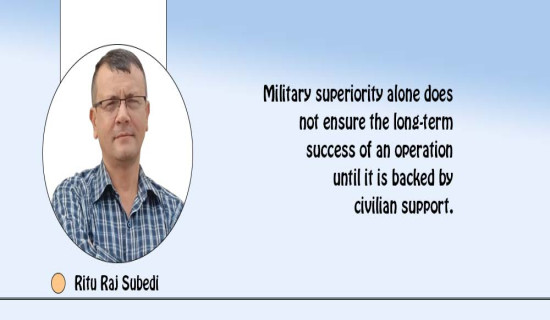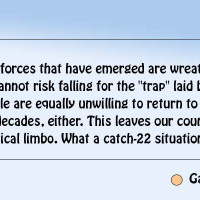- Monday, 12 January 2026
67th Diplomatic Anniversary Russian Aid To Nepal’s Development
Nepal and Russian Federation today mark the 67th anniversary of the establishment of diplomatic relations between them. In 1957, Russia, which was then known as Union of Soviet Socialist Republics (USSR) or Soviet Union in short, had just reached its peak of development and was ready to fly into space after 40 years of the October Revolution, unrest, wars and construction. In the same year, the two nations opened their bilateral ties, which have spread to diverse fields of mutual cooperation and development.
Since 1957, Russia has started providing scholarships to Nepali students for higher studies. More than 7,000 specialists have been graduated from different Russian universities. Many of them have been working as scientists, engineers, doctors, and agronomists, among others. Apart from producing high skilled human resources for the country, it has also provided significant development assistance to Nepal in the establishment of vital infrastructure in agriculture, industry and transportation sectors.
Hydropower development
The Panauti Hydropower is the first megawatt (MW) capacity station constructed with assistance of the Soviet Union in 1965. The four-kilometre headrace canal built as part of this project has turned thousand hectares of land into fertile fit for the cultivation of cash crops. This is why Panauti is popular for potato. Premises built then for the residence of the project still serve as the accommodation for Khopasi Hospital.
The Janakpur Cigarette Factory was another popular industry built as a gift of the then Soviet Union. The factory was the market leader during its heyday. It manufactured a slew of brands, each of which had a dedicated fan following. Initially two billion cigarettes were produced annually from this factory. Cigarette brands ranging from Yak, Deurali, Asha to Rhino used to be produced in the factory. It is very painful that the company had closed down in course of privatisation in 2010.
Birgunj Sugar Factory, another milestone of the country's industrial development, was established in 1964 with the help of USSR. It produced sugar and encouraged farmers to plant sugarcane as a lucrative crop. The factory had capability of crushing 1,500 metric tonnes of sugarcane and producing 10 metric tonnes of crystal sugar per day, as well as molasses. Once a flourishing public enterprise, the company started on its path to ruin on February 16, 2000 when the Cabinet decided to privatise it.
Another unique project, Nepal’s only agricultural tool factory was established in Birgunj with the help of the then Soviet Union in 1968. The factory produced agricultural tools like ploughs, tillers, threshers, pumps, etc. At that time Birgunj's products were preferred not only by the local farmers but also by those in the neighbouring country and Nepal used to export some of the agricultural supplies to India.
Another key project constructed by the USSR is Dhalkebar-Pathlaiya section of Mahendra highway. At the request of the late King Mahendra in the international arena to assist Nepal in the construction of the East-West Highway, one of the longest 109-km stretches of the section. After the involvement of the Soviet Union, other countries also supported the highway construction. Kanti Children's Hospital is another institution set up with the assistance of Russia. This is one of the pioneer children’s hospitals established in 1963. This was a vital humanitarian aid to Nepal. Besides, Nepal Rosin and Turpentine Limited was established in 1987 in far western part of country with the financial and technical assistance from the former USSR.
These are few examples of contributions of Russia to Nepal. With the adoption of liberalization policy, almost such key industries gifted as token of love from the Soviet people, have remained shut since 2003 and now limited only to history. After the collapse of the Soviet Union, the Kremlin's development aid to Nepal dried up. However, it is good that Nepali entrepreneurs residing in Russia are investing in hydropower and other projects. The influx of Russian tourists is increasing. Lumbini and Himalayas are being the places of prominent attraction to Russians. A Russian Buddhist Temple is being built in Lumbini with the support of the Buddhist Sangha of Russia and the Public Chamber of the Republic of Buryatia. Russia has continued providing scholarships to Nepali students.
Willingness to further support
During the COVID-19 crisis, Nepal could not receive the benefit of Sputnik V vaccine offered by the Russian Direct Investment Fund. After the recent visit of National Assembly Chairman Ganesh P. Timilsina to Russia, the Russian Embassy sent a letter to Nepal asking for detailed proposals for 13 different projects that included Pokhara-Parbat-Ridi Road, Children Cancer Hospital, East-West Railway, scholarships, etc. In a brief interview with the media, the Russian side said: "Be it food, fertiliser, or fuel, we are ready to extend our helping hand. But we've not received any formal request from Nepal so far.”
During the Cold War, Nepal adhered to the principle of non-alignment. Russia respected the nonaligned foreign policy that Nepal had been pursuing for long. The Soviet Union was the country that selflessly helped Nepal in industrialisation of agriculture sector. We can't forget the Russian cooperation extended to us in a myriad of sectors. On this significant day, we are thankful to the Russian government and peoples for their continuous support and cooperation. Long live Nepal-Russia friendship!
(An engineer by profession, the author is a graduate of Soviet University.)










-(1)-original-thumb.jpg)






